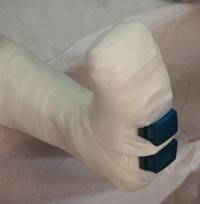New Study, Same Conclusion
It is time to take another look at Total Contact Casting
The most recent and perhaps the most conclusive study of for treatment of the diabetic foot is a collaboration of three prominent organizations, The Society for Vascular Surgery, the American Podiatric Medical Association and the Society for Vascular Medicine. The guidelines, “The Management of the Diabetic Foot,” were developed after three years of studies and are published online and in print in the Journal for Vascular Surgery. Dr. Anil P. Hingorani is the lead author that researched and wrote the guidelines. With diabetes a major worldwide problem and little data on treatments, the need for detailed, diabetic foot clinical guidelines from multiple disciplines was great, said Hingorani.
The committee synthesized the points of view of the three different medical professions by researching one another's treatment protocols. Vascular surgeons and vascular medicine specialists read literature from podiatry and vice versa, for example, and all participants concentrated on infectious disease control and guidelines, a large component of the finished document. Collaboration was key, Hingorani said. "We had multiple disciplines looking at the problem to bring the best information from each field to develop the guidelines," he said, though only limited "high-quality evidence" was available for many of the critical questions.
One of the findings that physicians may find surprising, it was the importance of the total contact cast in the treatment of plantar diabetic foot ulcers, which the committee found was is supported by robust data. Off-loading takes all direct pressure off the ulcer through use of a total contact cast. "total contact casting is so under-utilized," Hingorani said. "I think some surgeons may find it surprising and it may raise a few eyebrows. Many surgeons are not aware of how strong the evidence is for total contact casting. It is not new but not widely understood or implemented." |
|
 Total Contact Cast
Total Contact Cast |
Similar findings:
- Advances in Skin & Wound Care
There were significantly more amputations within a year for those with diabetic foot ulcers who did not have total contact casting when compared with those who did
- Journal of Wound Care
Offloading is a key treatment strategy for the management of diabetic foot ulcers and total contact casts were found to be the most effective devices to achieve ulcer healing
- Journal of Diabetes Science and Technology
Off-loading of the ulcer area is extremely important for the healing of plantar ulcers. Off-loading with total contact cast is superior to other off-loading strategies studied so far
- Medical Gazette of Mexico
A common error in this basic treatment is the method used for offloading, leading to delayed healing as a result, and maybe even amputation. For this purpose we propose the total contact cast considered the “gold standard” in diabetic foot offloading
- Diabetic Foot & Ankle
Total contact casting (TCC) has been considered as the gold standard in the treatment of neuropathic diabetic plantar foot ulcers. The utilization of a TCC reduces the mechanical forces, inflammation, and edema; redistributes the plantar pressure; limits bone and joint destruction; and can consolidate the progression of deformity
- Medical Clinics of North America
The Charcot foot is a problematic clinical entity that worsens in the absence of timely intervention. As of now, based on the American Diabetes Association consensus report, offloading with TCC continues to remain the mainstay of therapy for Charcot neuroarthropathy
For the treatment of the diabetic foot ulcer off-loading is absolutely critical and total contact casting is The Gold Standard of off-loading. *A comparison of the three major off-loading methods (total-contact casts (TCCs), removable cast walkers (RCWs), and half-shoes) reinforces this point. The proportions of healing for patients treated with TCC, RCW, and half-shoe were 89.5, 65.0, and 58.3%, respectively. A significantly higher proportion of patients were healed by 12 weeks in the TCC group when compared with the two other modalities.
If you are not providing TCC in your practice it is time to take another look. Applying a TCC is not as difficult as you might think (application video) and reimbursement has increased as of last year to $223.30 **
If you are currently providing TCC in your practice you may have found that the lighter kits on the market simply will not withstand larger patients. The M-Med Mobility Series contains more components for superior versatility over other kits on the market and dry faster so your patients can go home shortly after an application. M-Med is the only US based provider of TCCs which results in significant cost savings to you and our customer support is the best in the industry. |
|
For a sample TCC kit please fill out this form - we will get back to you ASAP. For more information please visit our website or call (336) 645-5121

Please donate to the Save a Leg, Save a Life Foundation:

*
Off-Loading the Diabetic Foot Wound - A randomized clinical trial
** http://aawconline.org/wp-content/uploads/2015/11/ALERT_2015-HOPPS-Changes.pdf
|
|


